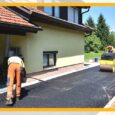Determining the best season for asphalt sealcoating is crucial for achieving optimal results and ensuring the longevity of the pavement. While sealcoating can be done throughout the year, certain seasons offer more favorable conditions that facilitate proper application and curing. This essay explores the factors to consider when choosing the best season for sealcoating, including temperature, weather conditions, humidity levels, and traffic volume. By understanding these factors, property owners can make informed decisions and schedule sealcoating at the most appropriate time, maximizing the effectiveness and durability of the sealcoat.
1. Temperature Considerations
Temperature plays a crucial role in the success of asphalt sealcoating. Ideally, the temperature should be above 50°F (10°C) and rising during the application and curing process. This is because the sealcoat needs sufficient warmth to dry and cure properly. If the temperature is too low, the sealcoat may not cure completely, leading to a weaker and less durable surface. Conversely, if the temperature is too high, the sealcoat may dry too quickly, making it challenging to achieve a smooth and uniform application. Therefore, it is recommended to schedule sealcoating during the spring or fall seasons when temperatures are moderate and more conducive to proper curing.
2 Weather Conditions
In addition to temperature, weather conditions also play a significant role in the success of sealcoating. Ideally, sealcoating should be done on a clear, dry day without any precipitation. Rain or high humidity can interfere with the application process, preventing the sealcoat from adhering properly to the asphalt surface. Moisture can also cause the sealcoat to take longer to dry, prolonging the curing time. It is important to allow sufficient time for the sealcoat to cure before any rain or moisture occurs, as this can compromise the quality and effectiveness of the sealcoating. Therefore, it is advisable to monitor the weather forecast and choose a period of dry weather for sealcoating.
3. Humidity Levels
Humidity levels can also impact the success of asphalt sealcoating. High humidity can prolong the drying and curing time of the sealcoat, leading to potential issues such as tracking or smearing. Excessive moisture in the air can also prevent the sealcoat from properly bonding to the asphalt surface. Therefore, it is recommended to schedule sealcoating during periods of lower humidity to ensure optimal results. Typically, spring and fall seasons tend to have lower humidity levels, making them suitable for sealcoating.
4. Traffic Volume
Considering the traffic volume is another crucial factor when determining the best season for sealcoating. It is important to choose a time when there is minimal traffic on the pavement to allow for adequate drying and curing of the sealcoat. This helps to prevent any damage or disruption to the freshly applied sealcoat. Weekends or periods of low activity, such as holidays or vacation seasons, are ideal for sealcoating. By scheduling sealcoating during these periods, property owners can minimize the risk of premature wear or damage to the newly sealed pavement.
5. Local Factors and Recommendations
It is important to consider local factors and recommendations when determining the best season for asphalt sealcoating. Local climate patterns, weather conditions, and industry standards may influence the optimal timing for sealcoating in a specific area. Consulting with local asphalt professionals or contractors can provide valuable insights and recommendations based on their experience and knowledge of regional conditions. They can offer guidance on the most suitable season for sealcoating in a particular location, considering the local climate, weather patterns, and specific pavement requirements.
Conclusion
Choosing the best season for asphalt sealcoating requires careful consideration of temperature, weather conditions, humidity levels, and traffic volume. By scheduling sealcoating during the spring or fall seasons when temperatures are moderate, weather is dry, humidity is lower, and traffic is minimal, property owners can ensure optimal results and maximize the effectiveness and durability of the sealcoat. Additionally, considering local factors and recommendations can provide valuable insights and guidance for selecting the most appropriate timing for sealcoating in a specific area.



